#Māori health model
Text
Embracing Balance and Resilience: Uniting Stoic Philosophy and Te Whare Tapa Whā for Holistic Well-Being
Stoic Philosophy and Te Whare Tapa Whā: Ancient Paths to Modern Resilience
Stoicism, an ancient philosophy birthed in Greece and refined in Rome, teaches mastery over one’s emotions through wisdom, courage, justice, and temperance. It advocates for clear, unbiased thinking and understanding the universal reason (logos), emphasising the importance of distinguishing what is within our control from…

View On WordPress
#ancient philosophy#balance in life#community wellbeing#cultural integration#emotional regulation#ethical living#holistic wellbeing#inner harmony#mental health#mindfulness#modern resilience#Māori health model#personal growth#physical wellbeing#resilience#social ethics#spiritual wellbeing#Stoic virtues#Stoicism#Te Whare Tapa Whā
0 notes
Text
New Zealand's new government says it plans to scrap the nation's world-leading smoking ban to fund tax cuts.
The legislation, introduced under the previous Jacinda Ardern-led government, would have banned cigarette sales next year to anyone born after 2008.
Smoking is the leading cause of preventable deaths in New Zealand, and the policy had aimed to stop young generations from picking up the habit.
Health experts have strongly criticised the sudden reversal.
"We are appalled and disgusted... this is an incredibly retrograde step on world-leading, absolutely excellent health measures," said Prof Richard Edwards, a tobacco control researcher and public health expert at the University of Otago.
"Most health groups in New Zealand are appalled by what the government's done and are calling on them to backtrack," he told the BBC.
The legislation passed last year had been acclaimed internationally with research models backing the key reforms.
Measures included restricting the number of tobacco retailers, and reducing the level of nicotine in cigarettes.
Modelling had suggested the Smokefree laws could save up to 5,000 lives each year.
New Zealand's laws were believed to have inspired the UK government in September to announce a similar smoking ban for young people. A spokeswoman said Prime Minister Rishi Sunak's position remained unchanged after New Zealand's reversal.
While it has been praised as a public health policy, the Smokefree measures drew opposition from some business groups in New Zealand. Owners of newsagents and corner shops criticised the loss of revenue - even with government subsidies.
Some lawmakers - including the new Prime Minister Chris Luxon - also argued a ban would lead to a black market for tobacco.
However his National party, which won 38% of the vote in the 14 October election, hadn't mentioned the Smokefree laws during election campaigning. The announcement by the new finance minister Nicola Willis on Saturday that the government would repeal the laws shocked health experts who believed the policy would be untouched.
But Ms Willis said National's partners in the governing coalition- the populist New Zealand First and libertarian Act - had been "insistent" on reversing the laws.
Despite election victory, the centre-right National party has struggled for weeks in policy negotiations to form a government with the two minor parties.
A deal was only agreed to on Friday, six weeks after the election, allowing the new government to be sworn in on Monday. New Zealand First - which won 6% of the vote - had been the only party to campaign on repealing the smoking laws.
Both minor parties blocked a flagship National policy to open up foreign property ownership - which the party had been relying on to fund tax cuts for middle and higher-income earners. Ms Willis said on Saturday that had led to the party looking elsewhere.
"We have to remember that the changes to the Smokefree legislation had a significant impact on the government books, with about a billion dollars there," she told New Zealand broadcaster TV3's Newshub Nation.
The laws still need to be actively repealed through parliament, where the government has a majority.
"The suggestion that tax cuts would be paid by people who continue to smoke is absolutely shocking," Emeritus Prof Robert Beaglehole, chair of New Zealand's Action for Smokefree 2025 committee told Pacific Media Network.
A national Māori health organisation, Hāpai Te Hauora, called it an "unconscionable blow to the health and wellbeing of all New Zealanders".
Smoking rates, and associated disease and health issues, are highest among New Zealand's indigenous Māori population, for whom experts had said the policy would have the most positive impact.
"The government is flying in the face of public opinion and obviously in the face of the vast majority of people who work in this field, health professionals, doctors, nurses," said Prof Edwards.
Public health modelling conducted in 2022 had shown the Smokefree policy would have saved New Zealand's health system about NZ$1.3bn (£630m; $790m) over the next 20 years.
New Zealand still aims to reduce its national smoking rate to 5% by 2025, with the aim of eventually eliminating it altogether.
More than 80,000 adults have quit in the past year, its national data shows. Currently, about 8% of its adult population smokes.
3 notes
·
View notes
Text
Anthems August Newsletter
Tēnā koutou e te whānau and welcome to Anthem’s monthly update!
Following a month filled with many celebrations and successes for our clients and the team, we are all looking forward to putting away the winter coats and welcoming the warmer weather and longer days this spring.
We are very proud to be named a finalist in PRovoke Media’s 2023 Australasia PR Consultancies of the Year Award.
This month the team supported the Aged Care Association with its latest campaign ‘The Domino Effect’, and we hope that together with Chemistry our work can make a difference to improve the aged care sector crisis.
We had an energetic response to the refreshed V Green, continuing our work with Frucor Suntory to bring the lifted flavour to superfans across the country.
Anthem supported Batik Air as they touched down in Auckland, launching a new service flying between Auckland and Perth on the Boeing 737 MAX 8.
The team worked with our friends at New Zealand Story to shine a spotlight on Kono NZ, the world’s first Māori-owned wine business and a proud member of the FernMark Licence Programme.
Rounding out with Anthem life, this month we enjoyed an evening with a handful of our agile team members, a lunch out to celebrate two of our teams going above and beyond for Anthem’s clients, and welcomed our furry friends into the office for international dog day!
Aroha nui.
Best wishes from the Anthem team
ANTHEM ANNOUNCED AS A FINALIST IN 2023 PROVOKE MEDIA AWARDS

The Anthem team is over the moon to have been announced a finalist in PRovoke Media’s 2023 Australasia PR Consultancies of the Year Award. We are grateful to be the only solely New Zealand independent agency shortlisted in this category, and to stand alongside a stellar line up of trans-Tasman and Australian consultancies.
Thank you to our talented team for their excellence and dedication, and to our clients for your trust and inspiring work which has allowed us to get here.
The winners will be announced in late September, so fingers crossed!
THE DOMINO EFFECT OF UNDERFUNDING THE AGED CARE SECTOR

This year Anthem has been supporting the New Zealand Aged Care Association with the launch of its new campaign ‘The Domino Effect’ which aims to raise awareness of the dire situation facing our aged care sector. The campaign, which we developed in partnership with creative agency Chemistry, shows aged care beds falling like dominoes to emphasise how the crisis affects every-day Kiwis - from families stepping in and providing care for their older parents, to the ongoing impact on our health workers who bear the brunt of the overwhelmed and underfunded system.
The Aged Care Association is hoping ‘The Domino Effect’ will entice action to provide a sustainable funding model to ensure quality aged care can be provided for those that need it now, and in the future.
As part of this work, Anthem Executive Director Sarah Geel spoke to the 500 delegates at the 2023 New Zealand Aged Care Association conference about the important role the sector has in championing the message to spread the Domino Effect.
BATIK AIR TOUCHES DOWN IN AUCKLAND
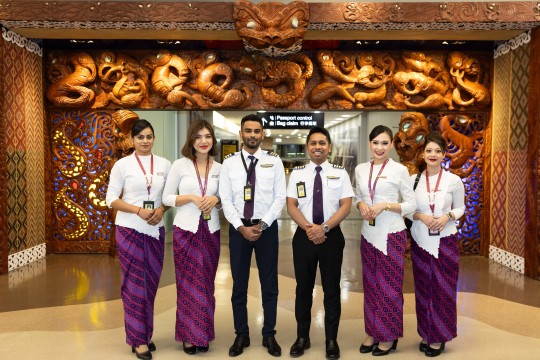
We had our heads in the clouds this month helping to welcome a new player into the New Zealand aviation market, with the launch of Batik Air’s Auckland to Perth service.
The Malaysian airline is part of Indonesia’s Lion Air Group and operates the route six times a week, with further onward connections to Kuala Lumpur using a Boeing 737 MAX 8.
Interestingly, around 85,000 Kiwis live in Western Australia, and travel between Auckland and Perth is back to about 96% of pre-pandemic levels, higher than the overall return to international travel (77%).
The launch attracted lots of interest, including from Stuff and NZ Herald
V GREEN GETS A TASTELIFT
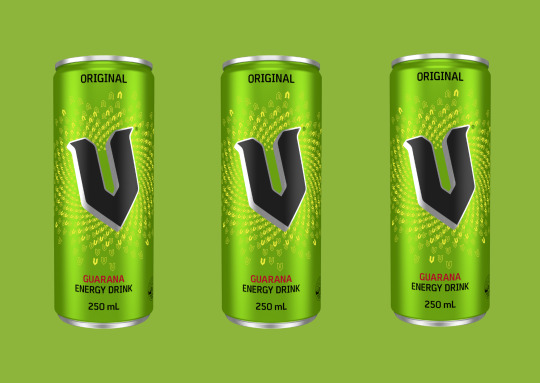
Building on last month’s launch of Frucor Suntory’s refreshed V Green, we engaged a number of influencers and fans to spread the word on the smoother V Green, Kiwi’s favourite energy drink, following its flavour tastelift. Our team worked hard to make sure more fans were able to get their hands on the drink by delivering random drops to superfans.
THE FERNMARK LICENSEE LIVING BY A 500-YEAR PLAN
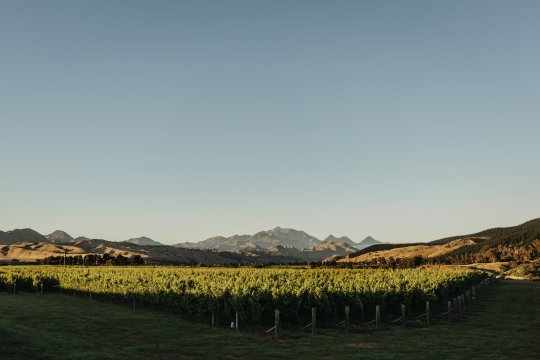
Every month, Anthem works with New Zealand Story to spotlight a business involved with its FernMark Licence Programme.
We recently enjoyed speaking with Dan Taylor from Kono NZ, the world’s first Māori-owned wine business. Taylor discussed how Kono NZ is led by a 500-year intergenerational plan called Te Pae Tawhiti, which instils a unique focus on preserving and enhancing the taonga of the regions in which it operates.
Kono NZ is proud to carry the FernMark because it instils confidence in the global market about the quality of its products, and bolsters the traceability and authenticity of its Kono and Tohu wines.
Visit the New Zealand Story website to discover more about the FernMark Programme and Licensees and learn more about the mana behind Kono NZ.
ANTHEM LIFE
Meet our Agile Team
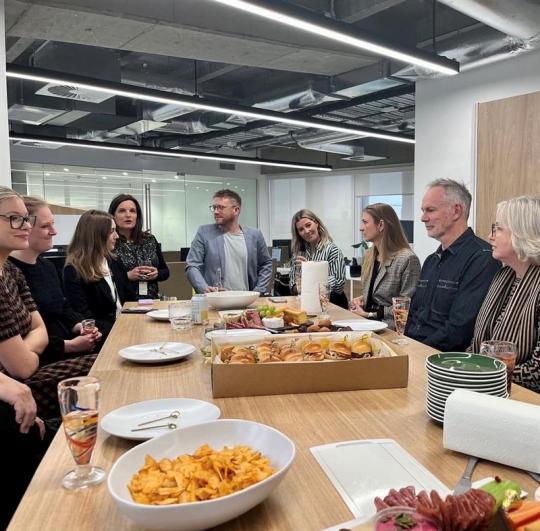
We operate an agile team model at Anthem which means we enjoy working with a diverse range of specialists and communications professionals, who bring their individual skills and knowledge together to achieve specific, critical business outcomes for our clients. However, we don’t always get the chance to meet face-to-face.
Last week we welcomed a handful of members from our wider team to the office, to learn more about their varied careers and life experiences. To Sir Bob Harvey, Paul Hewlett, David Thomason, Louise Nicholson, and Georgina Bond, we loved having you here and hearing about your careers and past lives!
To all our agile team, a huge thank you for bringing your specialist skills, industry expertise, diligence and enthusiasm to our table.
Celebrating International Dog Day 🐕

Last but certainly not least, the Anthem team was sure to celebrate International Dog Day as a very important day in the month of August. We welcomed three furry friends, Rosie, Billie Waka and Kahu into the office, providing doggie donut treats for the dogs and dog-themed cookies for the team too of course! That's our wrap for the month!
Kia pai to rā
from the Anthem Team
0 notes
Text
Tangata tiriti and Whare Tapa Whaa
25th August (Fri)
Description
Before starting Week 6, I created a new timeline to keep the project productive for the next three weeks. Since I was studying two design classes at the same time, I distributed the work as evenly as possible so that the project could follow the previous timeline. The new timeline has the advantage of allowing me to write down my daily schedule so that I can see my daily goals at a glance.
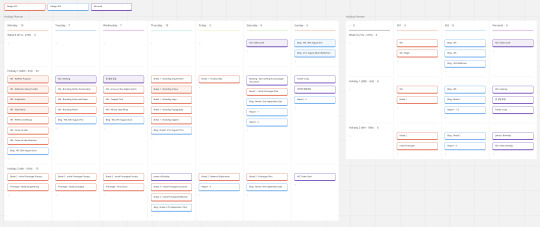
-> From the Miro board, Week6 to Break daily and weekly timeline
Before I started to develop my ideas, I did two activities that I needed to consider as a community stream.
Firstly, I reflected on my own project as a Tangata Tiriti (Treaty partner) and thought about what the Treaty meant to my project. I considered the 3 P's and analysed how protection, partnership and participation (2) were being upheld in my project.
The second activity involved researching the Māori health model, Whare Tapa Whaa, analysing my project through the four components of Whare Tapa Whaa, and analysing how my project impacts the well-being of the Māori community.
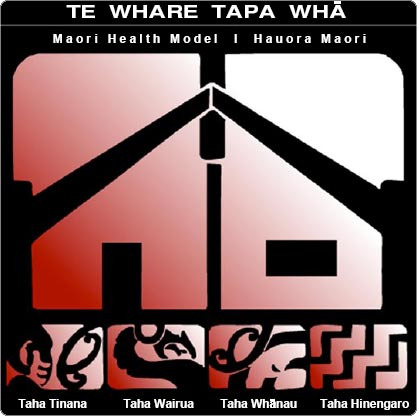
-> Te Whare Tapa Whaa; Māori health well-being model(3)
Feelings
The timeline is always a great way to see at a glance what stage I'm at in a project and to see what parts of the project could be improved. I enjoy creating timelines and to-do lists. Writing a daily to-do list and checking off what I've done at the end of the day helps me keep track of the progress of my projects and makes me proud of myself. Writing a to-do list also helps me keep track of my mental health, as it reassures me that I'm doing a good job.
This week, I took it relatively slow, but I think proper rest is essential when working on a long-term project. As the Whare Tapa Whaa model shows, both physical and mental health is essential to good health, so I think overworking and not being able to judge my limits can lead to burnout, so by taking a break now that I'm halfway through the project, I'll be able to work harder in the future.
Evaluation
Project process 3/5 - Although the main project flow hasn't progressed, I've been able to work on issues that I need to consider as a designer while working on the project.
Time management 5/5 - Thanks to my new timeline and detailed daily to-do list, I feel like I'm managing my time well enough even after taking a break.
Project result 5/5 - It was a great opportunity to better understand my project and learn about Tangata Tiriti and the Whare Tapa Whaa model.
Analysis
I think a detailed timeline works well for me because it allows me to see the process at a glance. As a designer constantly thinking about the future of the project and the process, it's nice to see at a glance what stage I'm at and where I need to move forward without having to check every time.
However, I think the downside of a detailed timeline is that it's easy to get stressed out, and it also has the limitation of not adding new timeline methods or new processes because once you've adapted to a less detailed timeline, you're stuck with it.
Conclusion
Through the Community stream activities, I was able to better understand and reflect on my project. As a designer, I think it's important to have a good understanding of one's positionality and the context and place of the project, so this was important for me because it allowed me to learn about the Aotearoa and Māori backgrounds of my project.
However, detailed timelines aren't for everyone - not all designers can understand them, and everyone has their own style - as an example, they work without a plan. This allows them to try different processes and make new discoveries that they hadn't thought of before, and I like to learn from their methods. I want to have more freedom in the background of a project and design without creating my own limitations.
Action Plan
Now that I've realised the usefulness of a daily to-do list, I think I'll plan a more detailed timeline if I'm working on another project, but I'll be careful not to limit my creativity and process, and I'll set aside some unplanned time to let my project unfold.
Next Plan
For the rest of Week 6, I'll work on developing the initial ideas and find more creative ideas that I can add to the final.
Start branding by finding the positionality and recap my aim and the vision of the prototype toolkit.
Reference
Ayla. (2023). Te Tiriti o Waitangi. Design 201
(2) Debbie Robertson. (2021). Te Tiriti o Waitangi - The Treaty of Waitangi. Papanui Primary School. https://hail.to/papanui-primary-school/publication/AGYREXN/article/uTWRISl#:~:text=The%20three%20%E2%80%9CP's%E2%80%9D%2C%20as,under%20the%20Treaty%20of%20Waitangi.
(3) Mental Health Foundation of New Zealand. (2023). Te Whare Tapa Whā. MHAW. https://mhaw.nz/explore/te-whare-tapa-wha/
0 notes
Text
Compare and Contrast two Human Development Theories Essay
EDUC102 Human Development
Bronfenbrenner’s Bioecological Model and the kaupapa Māori approach to holisitic health and human development as described by Sir Mason Durie as Te Whare Tapa Whā are two models which can used to chart the connections and interplay between relationships, peoples, places, and things.
Te Whare Tapa Whā is a traditional model and a metaphor for the holistic health, education and wellbeing of an individual, community or institution envisioned as a house supported by four posts, rooted in the whenua. In te ao Māori an individual cannot be taken without their community and wider cultural context. Likewise each aspect of health cannot be taken on it’s own, Mason Durie (1985) describes the four cornerstones of health as te taha wairua, the spiritual dimension, te taha hinengaro, a psychic dimensionm, te taha tinana, a bodily dimension, te taha whanau, a family dimension.
From this perspective these are intrinsically linked and collaborate to the great whole. The failing of any one taha, side, of the whare then unbalances the whole, is unhealthy and could fall.
An example given by Durie (1985) where a person who physically fit and strong but who thinks only of themselves would be considered unhealthy as while their taha tinana stands strong, with his taha whānau and taha wairua unable to carry their weight, so is the house unstable.
In regards to Human Development, Te Wharie tapa Whā presents a Māori traditional view of cognitive grow as from “synethisis to a wider, contextual system” (Durie, 1985, wh. 484) rather than dividing and categorising.
Bronfrenbrenner’s Bioecological Model is a system to divide and categorise. Bronfrenbrenner developed his model with the purpose of creating a theoretical perspective for research of human development (Bronfenbrenner, 1979). This perspective models how a situation, person or enviroment relates to a subject. This expanded to form identifiable systems to describe and define proximal distances and groupings to provide a framework for writing about relationships and influences (Clark & Grey, 2010).
The model consistences of concentric circles each describing the level of connection to the subject and nested within the next to explain the repricocal individual-enviromental influences on the subject (Ministry of Education Te Tāhuhu o te Mātauranga, 2017).
Of these systems, the microsystem and mesosystems, denoting the direct influences and those directly connected to them, nested within the exosystem, the first level of external and non-direct influences.
To imagine the model in the context of a child study. Into the microsystem is classified child’s immediate enviroment, whānau, class and friends. All that directly interactions with or influences the child (Drewery & Claiborne, 2019). The child has more than one microsystem which each centred on the child within different contexts and including what effects them within that context, such as each class.
Defined to the mesosystem are the connections that link the child’s microsystems together and how they connect to the child (Bronfenbrenner, 1979), such as the wider school community those class microsystems together or the interactions between parents and teachers as they effect the child.
The exosystem however is not the links between mesosystems but the structures that the child does not interact with, effecting the child (Drewery & Claiborne, 2019). Ministry of Education decisions effecting the child’s schooling or the parent’s relationships with their collagues as examples of acting influences on the child’s life from their exosystem.
The model also contains the macrosystem for wider cultural, global and political influences and the chronosystem to categorise effects from the passage of time, age of the child or times lived through among other influences that fall under time (Drewery & Claiborne, 2019).
Pseudonym Early Childhood is a community-based centre managed by a parent committee who set the centre philosophy and make all the decisions as to the development and future of the centre. Every day alongside the two full time and one part time teaching staff, is a parent help, assigned by roster from the whānau to be present at centre, work with tamariki and help with the clean up. This set up was complimented with additional temporary support in student teachers from teacher’s college and polytechnic, teacher aides for the tama in need of special assisstence and speech and language development therapists.
This level of whānau involvement ties into both theorist’s models. The close partnership with whānau, presence of those relationships and figures within the centre connects to Bronfronbrenner’s Bioecological model as they can be described as from the micro- and meso- systems and they tie into Mason Durie’s explanation of Te Whare Tapa Whā as this is the centre upholding learners taha Whānau and their taha Whānau upholding the centre through repricopral connections and involvement.
Through the whānau involvement came the centre’s specific karakia and te Tiriti o Pseudonym through the involvement of Māori families and local marae. This involvement constructed within the centre it’s taha Wairua, providing a foundation and framework for considering the wairua connections and mana of the tamariki and whānau within the centre.
The constant consultation and partnership between the centre, kaiako and the Whānau from a perspective based in Bronfenbrenner’s model this is bringing the decision making and governance that would be in the exosystem into the meso- and microsystems and as such ensures that decisions are made with the knowledge of and relationships with the tamariki, kaiako and enviroments effected by them.
Although the centre is quite small, on a residential section it makes use of what land it has to connect to nature. Garden plots and compost and an emphasis on native and fruiting plants. This shows an acknowledgement of the Whenua from te taha wairua Mason Durie’s Te Whare Tapa Whā (Durie, 1985). From interactions with this enviroment learning on gardening, food sources, collective mahi and the living world the other posts are strengthed. Through tamariki’s funds of knowledge brought from farming whānau into gardening activities taha Whānau connections are reinforced and celebrated. The activities through digging, weeding and watering uphold tamariki’s taha Tinana as through them are developed their hand eye co-ordination, balance and physical skills and the product of gardening, for example the Kale which was baked into chips, healthy food again upholding that post.
The Bronfenbrenner approach to these contexts sees these connections, decisions and policies of the centre as tied into the micro- and mesosystems of the centre as the level of whānau involvement prevent deliniation between the systems. There is free movement between the rooms and outdoor space and with the service only providing for over 2s no age separations. As parents are involved in the centre life through the parent help roster, frequent visits from siblings and parents being allowed to come and go at any time during service hours the tamariki’ mesosystems are largely contained within the centre microsystem, the interactions between the centre systems of home life being open and fluid.
A child’s grandparents visited the centre to facilitate a carpentry activity shows this fluid approach and the advantages of both models. Within this activity two of the child’s microsystems were brought together strengthing their relationship with both and promoting engagement with that activity and the learning found within it. In the kaupapa Māori te Whare Tapa Whā perspective this activity saw two aspects of the child’s te taha Whānau, tipuna and kura to strength that pole while upholding te taha Tinana through the activity and te taha Wairua through the support of, and connection to the lessons of, their tipuna. As both models reach similar conclusions in this example this shows a case where the advantage of both theories to the instituting of activities and recognition of the gain to development, align despite contrasting underpinning theories as to why.
Te tiriti o Pseudonym and the personalised karakia mō te kai are the product of partnership and collaboration between the centre, Māori whānau at the centre and Arai Te Uru Marae. While under Bronfenbrenner’s bioecological model the whānau involvement would be placed within the micro- and mesosystems. The involvement of Arai Te Uru, a body not normally involved in the life of the centre or its whanau but instead representing the tangata whenua its built on the land of would be reaching to the exosystem. The wider connections to the urban marae as a place to stand for all Māori, as a macrosystem link, at a distance to the centre and to tamariki.
Seen from te Whare Tapa Whā however these links are close, and vital. Te taha Wairua is here the most basic and essential requirement to health and development. To have the karakia and centre tikaka, developed with partnership with kaumātua and representatives of local kaitiaki tie further into te taha Wairua and the deeper aspects of te taha Whānau through the connecting links of tīpuna. In this case, te Whare Tapa Whā would see the centre as unable to function healthily (Durie, 1985) without this involvement while Bronfenbrenner’s model would hardly see it as even relevant.
Where Bronfenbrenner allows you to draw links between microsystems and provide theorical underpinnings to promote drawing whānau and other microsystems into the life of the centre. Te Whare Tapa Whā covers those same links while providing the reasons and purposes behind them connected to a greater whole and includes the spiritual dimension and a deeper holistic understanding. The American developed Bioecological model also lacks relevance to a centre within Aotearoa’s cultural context compared to the traditional kaupapa model lacks awareness of the comprehensive needs of a centre underpinned by a bicultural curriculum built upon te whenua o Aotearoa.
Within this chosen context, examples and definitions, Bronfenbrenner’s model is eclipsed by Durie’s as its relevant aspects are fully contained within the more expansive four cornerstones model. Consequentially, taken as an underpinning theory, te Whare Tapa Whā is better placed to uphold the house of Pseudonym Early Childhood.
Bibliography
Bronfenbrenner, U. (1979). The Ecology of Human Development: Experiments by Nature and Design. Cambridge, Massachusetts: Harvard University Press. Retrieved from https://khoerulanwarbk.files.wordpress.com/2015/08/urie_bronfenbrenner_the_ecology_of_human_developbokos-z1.pdf
Clark, B., & Grey, A. (2010). Āta Kitea Te Pa - Scanning the Horizon: Perspectives on early childhood education. Melbourne: Pearson Australia.
Drewery, W., & Claiborne, L. B. (2019). Human Development: Family, Place, Culture. 2nd Edition. Sydney: McGraw-Hill Education (Australia) Pty Ltd.
Durie, M. (1985). A Māori perspective of health. Journal of Social Science & Medicine, 20(5), 483-486.
Jaeger, E. L. (2016). Negotiating Complexity: A Bioecological Systems Perspective on Literacy Development. Human Development, 59(4), 163-187.
Ministry of Education Te Tāhuhu o te Mātauranga. (2017). Te Whāriki: He whāriki mātauranga mō ngā mokopuna o Aotearoa. Wellington: Crown.
#EDUC102 Human Development#Bronfenbrenner is gross#Teacher's College#Bteach#Education#Early Childhood Education#1st Year#Essay#University Essay
0 notes
Link
0 notes
Text
Maori Health Model
Tie in a healthcare app with physical, mental, family and spiritual health.
Maybe a remote healthcare assistant that can help with the belief systems of the Maori?
Offer different ways to improve health through the different models of Maori health (Camera, Bluetooth, bpm tracker, etc.)
Diaries to keep track of different ways to improve the health in each area.
Recovery schemes that relate to Te Whare Tapa Wha?
Social models?
0 notes
Text
Class brainstorming and connecting
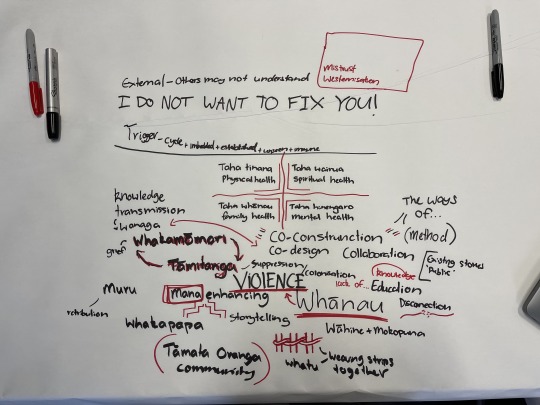
Whānau violence is not only a social, police, or justice issue – it is a health issue with lifelong holistic consequences. Serious consideration of the role of historical trauma, cultural disconnection, and its intergenerational effects is needed to address indigenous family violence. For adults and mokopuna living in its midst, whānau violence has a detrimental impact on the physical, mental, psychological, and spiritual health and wellbeing. For mokopuna living in homes where violence is present has significant and life-long effects on their social, health, educational wellbeing, and life expectancy. Recent international research found the health impacts are transmitted to subsequent generations.
Historical and contemporary disconnection from culture impact’s identity and access to the protective factors associated with a strong cultural identity and whānau connections. In reality, many whānau have no access to culturally-based support or healthy role models to assist in nurturing mokopuna to be healthy and well. Instead, these whānau rely on what they 'know' to prepare them to become partners and parents. Frequently, what at-risk whānau ‘knows’ can lead to mokopuna harm.
This important topic of whanau violence prevention to promote whānau ora and improved health outcomes for Māori must be communicated in ways that are meaningful and relevant to whānau Māori. This is particularly important within health research for Māori. Communication design helps to provide tangible, visual forms, and elements to better communicate important messages. A basic slogan such as ‘family violence is not okay’ on a poster may not necessarily accurately reflect, or effectively connect with whānau Māori.
0 notes
Text
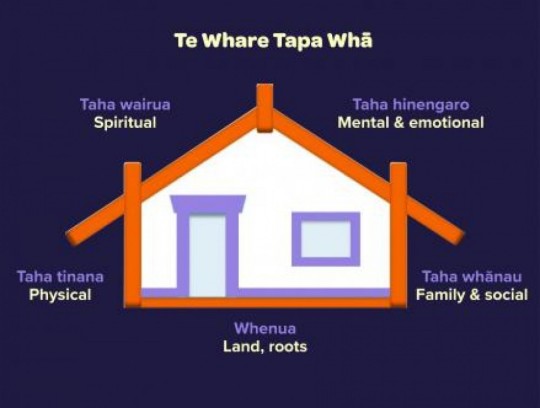
this is a mental health self assessment model I've always really appreciated!
Te Whare Tapa Whā was developed by leading Māori health advocate Sir Mason Durie in 1984. The model describes health and wellbeing as a wharenui/meeting house with four walls.
These walls represent taha wairua/spiritual wellbeing, taha hinengaro/mental and emotional wellbeing, taha tinana/physical wellbeing and taha whānau/family and social wellbeing. Our connection with the whenua/land forms the foundation.
When all these things are in balance, we thrive. When one or more of these is out of balance our wellbeing is impacted.
1 note
·
View note
Text
Medicine Interview tips (NZ)
Hi guys! Since I get quite a few questions on this I thought I might just make a massive post on how I prepared for the MMI + resources that helped me. :) x
First of all if you don’t know what the Multiple Mini Interview (MMI) is, I suggest reading this. The qualities they assess you on include the following:
Awareness of health issues
Career motivation
Communication
Conflict resolution
Creativity
Critical thinking
Cultural safety
Empathy
Ethical/moral reasoning
Quality of argument
Self-awareness
Self-care
Social responsibility
Teamwork
This MMI booklet helped me a lot in structuring how I would prepare for this interview. The booklet also has some good questions so I suggest you trying to form groups with your friends and practice! I basically divided my preparation into the following parts:
Personal bank
Having a personal bank of experiences in your mind will really help you in the interview since quite a few personal questions tend to pop up. Here are some questions/prompts you may want to consider:
Your strengths and when did you demonstrate them
Your weaknesses and how you account for them
How do you relieve stress?
What do you do for self-care?
What are some experiences that changed your outlook on life?
What makes a good leader / team member?
What are key qualities you think a health professional should have?
Why do you want to be a doctor?
Your role models and people you admire
Your goals, things that motivate you, etc
Experiences where you made a mistake and learnt from it
NZ Health system & NZ Health Issues
Being aware of NZ health issues and the health system is a key part of the interview.
Being my nerd self, I prepared for this by reading lots of articles online and typing up some notes. I don’t suggest going overboard with this, I only wrote down information that I think is super crucial; don’t go learning numbers/statistics, etc. They don’t expect you to learn the exact laws/policies behind each one of them either; the key thing is to have a general idea of each of these issues and have a general opinion on them.
It’s good to have a general opinion on the following issues and have reasons why (and acknowledge the opposing argument to your opinion, and why people may have this opinion):
Euthanasia
Abortion
Cannabis
Complementary and Alternative Medicine
Animal testing
Sugar tax
Vaping as an alternative to smoking
... etc
It’s important to be respectful when you get asked about the opposing argument to yours; as the Sample MMI scenarios document says, “Remember that you are not being judged on the “rightness” or “wrongness” of your answer. You and the interviewer will each have a personal point of view shaped by education, social conscience and personal experience... It is quite likely that you and the interviewer will perceive the issue differently but it is not where you stand that you are being scored, it is the way you discuss the topic and form your opinion. If, as the interview progresses, you find yourself changing your mind then don’t be afraid to say so. By the end you will have had eight minutes to think about the issue, not just two, and being prepared to shift your position shows that you are open to change and have gained something from the conversation. Any interviewer will view this positively.”
Finally, I also did some reading on NZ health issues and thought of some strategies to combat them:
Rural health crisis
Binge drinking
Maori health disparities
Poverty, Child Poverty, Homelessness, Inequality
Rheumatic fever
Housing crisis
Smoking
Obesity
... etc
Some resources:
NZ health system: 1, 2, 3, 4
NZ health issues: Wikipedia is a really good resource! (just search up e.g. “Obesity in New Zealand”)
Cultural Competence
The MMI booklet has a good section on this. As the booklet states, some key things to read up on are:
Māori health outcomes
The Treaty of Waitangi
Rongoā (Traditional Māori medicine)
MAPAS admission scheme
Health interventions targeting Māori/Pasifika groups
Resources:
Reid et al. (2017) Achieving health equity in Aotearoa: strengthening responsiveness to Māori in health research
Durie (1989) The Treaty of Waitangi and health care
Other tips
Compile a bunch of practice questions and practice with a group of friends! I personally found it really helpful to get feedback from other people. This is particularly helpful for the acting station.
Know your reasons for why you want to be a doctor - simply saying that you want to help people may not be enough; since other health professionals like nurses, etc do the exact same thing. Really think of why you want to be a doctor.
Don’t memorise answers since interviewers generally pick that up; just relax, go in and be yourself.
Relax before the interview!! Don’t go reading your notes before the interview since that will probably just stress you out. Play your favourite game the night before, light a candle, have a relaxing bath, drink your favourite drink before the interview! Motivate yourself!!
You can find acting station tips on the MMI booklet
Be careful when going to those free MMI workshops and take their advice with a grain of salt; I remember going to one in first year where they told me that it is important to stand firm when expressing your opinion because interviewers like to see that you don’t get easily swayed (which is completely untrue)
aucklandmed may run a free mock MMI, so watch out for that!
Read the Sample MMI scenarios put up by the university!
Here’s a really helpful youtube playlist.
MMI question bank
If you have any questions feel free to drop an ask. Good luck!! x
#medblr#medical school#medicine interview#medicine#med school#studyblr#studyspo#auckland med#university#mine#reblog#follow
11 notes
·
View notes
Photo
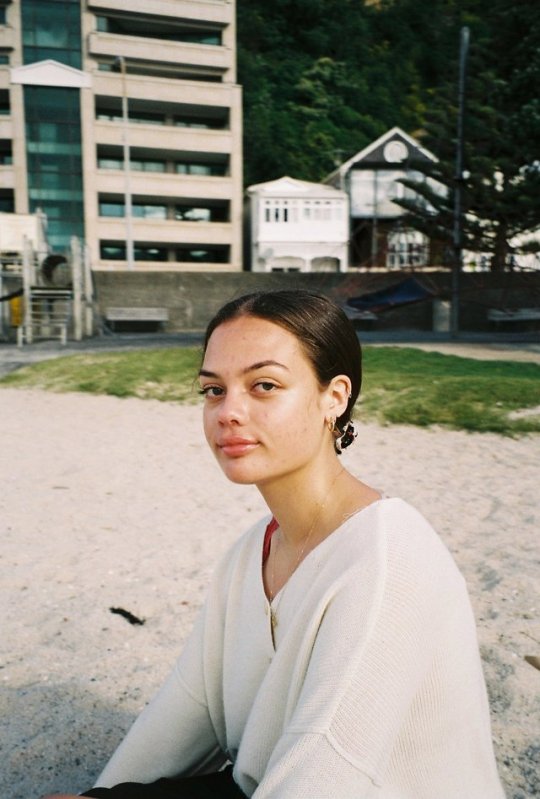
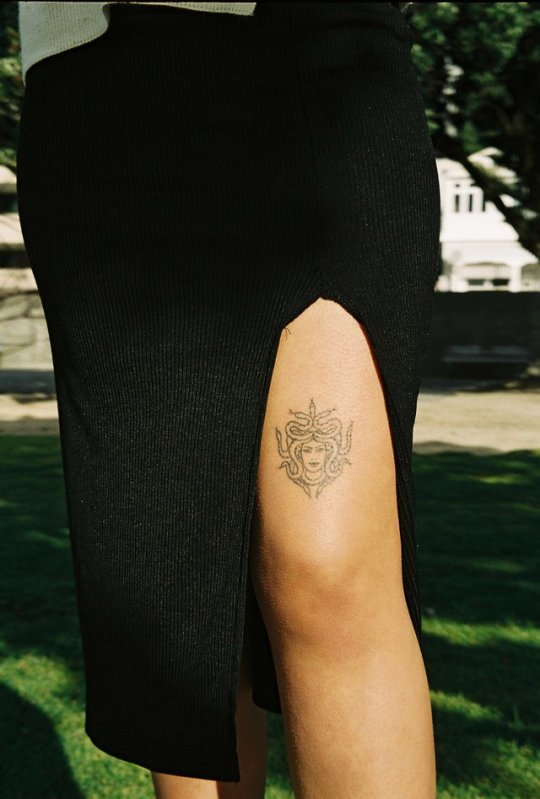


“It kind of started when I was seven, and I started dancing... It was just like being thrown into a room of naturally skinny white girls. I had a lot of baby fat, and my teachers started suggesting things – it was never like “oh, you need to lose weight,” but “maybe you should go for a run after class.” It just kind of went from there.. I wasn’t losing the weight, so they were just treating me like shit, and not really letting me compete or anything like that.
I went to a predominantly white school, a lot of the people around me didn’t have Pasifika or Māori builds. I was restricting myself heavily... Once a week, though, I’d just binge, and eat, like, KFC and Maccas and Pizza, all in one day. I knew something was wrong, but I didn’t think that was ‘me’, because of the representation I saw – you had to be stick thin, white. When I was 14, I lost my cousin to a murder, and I was in my first relationship, which was very emotionally abusive. I didn’t want anyone to know. I wanted to come off as perfect and put together, I felt you had to be that way if you wanted to be accepted as a brown girl.
No one ever really said, “you’re not okay.” After everything happened when I was 14, I started seeing a psychotherapist, and I remember one of them commenting on my eating, but they just treated it like a side effect of what was going on, rather than a big aspect of the situation... This year, I had a scare with my health, and realised I need to make the most of my life while I still have it. My only goal now is to be healthy. Another big tipping point in my recovery was hearing my younger nieces say that they want to model like me when they grow up. It made me realise that they were on track to go through what I went through, so I really want to be a better role model to them.
I’ve met big, brown rugby players that have eating and body issues themselves, but because no one’s including them in the conversation, they think it’s just who they are... We need to stop with the stigma that it’s only happening to skinny white people.” - Kitty, “Hunger” series.
1 note
·
View note
Text
Anthem December Newsletter
Tēnā koutou e te whanau and welcome to Anthem’s December newsletter!
As we look towards the end of another eventful year, it is a great opportunity to step back and appreciate all that has been achieved.
November was an eventful month for Anthem, our clients, and friends.
The latest edition of our Fair Enough? research series, in collaboration with Talbot Mills Research, was released. This edition saw us ask and answer: Is it fair enough to expect employees to turn up at their workplace when their employer requires them to do so? Is it fair enough that employers should adapt their business models to accommodate remote working? What do you think is fair enough?
The Spinoff partnered with Education New Zealand to share the importance of international student exchange programmes and the benefits they bring beyond classrooms.
Our client DOE Donuts shared pop-ups and pickle donuts in November, and is looking forward to an even more “jam”-packed silly season.
Pfizer provided Kiwis with top tips for COVID-19 going into the summer season.
New Zealand Story launched a podcast featuring the tales of successful Kiwi businesses that are proudly helping expand New Zealand’s global reputation.
We also helped Qrious share the incredible news of its $1 million paid internship programme for women, Māori, and Pasifika.
The annual Cure Kids Gala Dinner, celebrating over 50 years, helped raise much needed funds for health research to improve the lives of our tamariki.
Exsurgo founder and CEO Richard Little provided insights into his life as a health tech entrepreneur in a feature with NZBusiness Magazine.
Spark and Toitū Tahua reported the important role the finance and digital technology sectors have in reducing New Zealand’s carbon emissions.
Fullers360 announced an exciting partnership with Seachange to bring a premium zero-emission vessel to the Hauraki Gulf from September 2023.
In Anthem Life for November, we had our biannual team offsite to make a plan for the remainder of the financial year, we celebrated International Men’s Day, and we welcomed some new Anthemites to the fold.
Read on to learn more!
Kia pai to rā
Best wishes from the Anthem team
HOW FLEXIBLE AND REMOTE WORKING POLICIES ARE SHAPING ORGANISATION'S REPUTATIONS
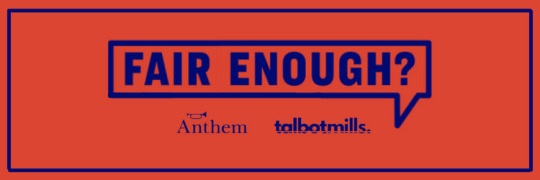
Our research series Fair Enough?, in partnership with public opinion research company Talbot Mills, is aimed at analysing organisational reputation through a fairness lens. Our latest edition saw us ask and answer the questions: Is it fair enough to expect employees to turn up at their workplace when their employer requires them to do so? Is it fair enough that employers should adapt their business models to accommodate remote working?
With the war for talent New Zealand is amid, emerging flexible and remote working options make companies and organisations desirable places to work. As communications specialists, we know that organisations need to be communicating this in their employee value proposition in order to attract the talent they need.
To learn more about the results of our research and its implications for organisations thinking about their remote and flexible working policies (hint: every organisation should be!) we’ve compiled our key takeaways below.
The Fair Enough? podcast brought together industry leaders to discuss what organisations should be considering when creating flexible working policies
The Listener’s Sarah Catherall discusses our research and its implications for the post-Covid working norm
BusinessDesk’s Pattrick Smellie shares his main takeaways from the research in
On The Money
For the data-lovers out there, read the full research findings on the Anthem blog
THE SPINOFF TALKS EDUCATION EXCHANGES

Education New Zealand partnered with The Spinoff to share the surprising benefits that international exchange programmes bring to students and to New Zealand.
The article comes after New Zealand's ESOL sector experienced a 92% increase in enrolments between August and September.
The article shares thoughts from sector leaders and international students on their views and lived experiences with international exchange programmes, how these benefitted them, and how it brings positive contributions to New Zealand.
Learn more about the value of educational exchanges
DOE-NUT MISS OUT ON THE CHRISTMAS CHEER!

Our client DOE Donuts had a bumper November, starting with a sold-out pop-up at Commercial Bay. CBD workers enjoyed delicious flavours like Biscoff Cream and Dark Chocolate Tiramisu… so much so that the DOE team sold out within three hours across three days!
The creativity didn’t stop, as DOE celebrated International Pickle Week with a tantalising collab with McClure’s pickles. The ‘Dickle’ – the perfect combination of sweet dough and glaze alongside savoury pickles and feta – was a hit across media and social, with some radio hosts even getting in on the fun and trying the donut on air.
Now with its focus on the silly season, DOE has launched its limited-edition MistleDOE boxes, packed with festive flavours like fruity pavlova, spiced gingerbread, and creamy eggnog. With a range of different box sizes available from 1st to 23rd December, there are variations to satisfy all Christmas needs this holiday season. We encourage you to join the festive fun and try DOE’s creations for yourself!
Order your very own Mistledoe treats
PFIZER SHARES COVID CONCERNS AHEAD OF SUMMER

Anthem’s client Pfizer released new research in November which examined how Kiwis are feeling about the pandemic as COVID-19 cases continue to rise ahead of summer.
It found that more than half of New Zealanders remain fearful of contracting COVID-19, and only 14% feel their life is back to normal post pandemic.
The research findings and the implications they have on Kiwi summer have been published across a range of media, including TodayFM, Radio NZ, and Stuff.
Learn more about Pfizer's research
NZ STORY FLYING THE FERN PODCAST

The Government’s nation branding agency, New Zealand Story, has launched a podcast featuring the tales of successful Kiwi businesses who are proudly flying their national symbol to help expand New Zealand’s global reputation.
Hosted by CEO David Downs, Flying the Fern features 24 exporters and FernMark Licensees who have achieved international sales success, with a focus on storytelling that embraces country of origin and provenance values. Business profiles include Ecostore, Ārepa, Book Me Bob, Hybrid Bikes, FarmIQ and Trust Codes.
“We hope that by sharing the raw, behind-the-scenes stories of how these Kiwi businesses used their ‘New Zealandness’ to break into offshore markets, other companies can take inspiration in the way they brand their own products and services,” says Downs.
“Sharing these stories can help continue to enhance the value of ‘brand New Zealand’ – in fact New Zealand’s brand value shot up 13% from 2021, to US$248 billion in 2022, according to Brand Finance Nation Brands.”
Listen to the podcast
QRIOUS LAUNCHES DATA ACADEMY

A $1 million paid internship for women, Māori, and Pasifika has received significant interest since its recent launch by Qrious, Spark Business Group’s AI and data analytics specialist.
The Qrious Data Academy is a talent pathway initiative that includes $1 million of paid internships to facilitate a pipeline of local talent into high-demand technology careers in the artificial intelligence and data analytics industry.
The programme has been welcomed by the local technology industry and advocates for tackling the skills shortage problem through dedicated career pathways for underrepresented communities.
“We know that the technology sector – particularly artificial intelligence (AI) and data analytics - is set for exponential growth over the next few years, and we want to play our part through an industry-leading programme that encourages, nurtures, mentors and upskills the next generation of New Zealanders,” says Evan Wilson, Qrious Head of Data Innovation.
The launch has generated strong demand for applications, with the majority of placements already filled for the 2023 programme.
Read more about the Qrious initiative
CELEBRATING 50 YEARS WITH CURE KIDS

Members of the Anthem team put on their best dancing shoes to join Cure Kids at its annual Gala Dinner. This year’s edition was a special milestone as the non-for-profit celebrated 50 years of ground-breaking child health research.
The gala, MC'd by The Lady Killers' Jackie Clarke, helped raise over $100k to fund vital research to help our tamariki.
One of the highlights of the night was a one-of-kind bespoke pearl necklace designed by Dame Trelise Cooper, which fetched $20,000 in a live auction.
INSIGHTS INTO THE MIND OF A HEALTH TECH ENTREPRENEUR

Our client Exsurgo’s founder and CEO Richard Little sat down with NZ Business magazine to shed some insights of his life as a health tech entrepreneur.
Richard gives a peek of his journey from chance encounters in airport lounges to pioneering the largest clinical trial of its kind. We learn about his two biggest inventions to date – the Rex Bionics exoskeleton and the Axon chronic pain headset – and the stories that inspired their creation.
Learn more about Richard and Exsurgo's story
CLIMATE AND BEYOND

Anthem clients Spark and Toitū Tahua, the Centre for Sustainable Finance, both released reports on their industry approach to climate challenges and progress on sustainability goals in November.
Spark’s report, ‘Meeting the climate challenge through digital technology’, outlined how 42 percent of our country’s CO2 emission reductions goals for 2023 could be met by using enabling digital technologies.
In its report, Toitū Tahua voiced the need for a tool to define what constitutes sustainable economic activities in New Zealand.
Anthem is proud to be supporting our clients on their meaningful and sustainable goals through strategic communication.
FULLERS360 ANNOUNCES FIRST ZERO-EMISSION TOURISM OFFERING FOR THE HAURAKI GULF
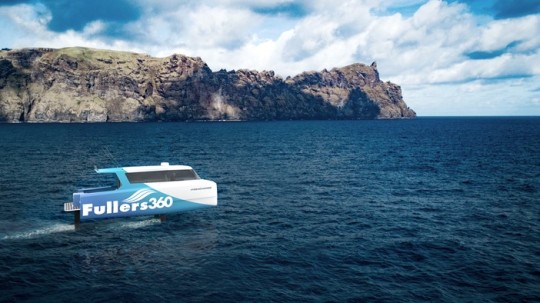
This week, Fullers360 announced it has partnered with Auckland-based sustainable boating designers, Seachange, to bring a premium 10-seater zero-emission hydrofoiling F8 vessel to the Hauraki Gulf from September 2023.
We are proud to support this significant milestone in the business’s decarbonisation journey, which will mark a new era in high-end tourism for Aotearoa New Zealand.
Read more here
ANTHEM LIFE
Team offsite

In November, the Anthem team had our biannual team offsite, with the goal of acknowledging what we’ve achieved in the past six months, whilst attaining some ideas and insights for achieving a ‘Best Place to Work’.
We split into four teams, each tackling a particular topic around fostering a better work environment and culture. The event proved to be both motivating and productive, giving everyone a chance to showcase their ideas which could in turn be implemented to foster an optimal place of work that enables everyone to thrive.
Acknowledging the men of Anthem

Caro and Jane took the men of the office out for lunch of their choice to celebrate International Men’s Day last month. Somewhat predictably, they chose a pub as their choice of venue!
In an industry traditionally full of women, it is always a pleasure working alongside the men of the industry who share their talents and passion to help Anthem and our clients find their most powerful voice.
New Anthemites
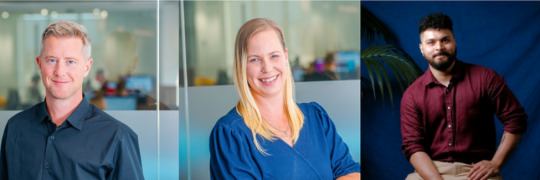
November saw us welcome three new members into the Anthem team.
Ben Mabon joined us as a Senior Account Director, bringing a wealth of creative and strategic communications experience. Ben has more than 20 years’ experience in internal and external communications and corporate affairs with companies in sectors including financial services, entertainment, primary industry, and local government.
We also welcomed a new Finance and Operations Assistant, Tamara McGill. Tamara, who has a proven background in diverse professional accounting roles, brings over 10 years' financial experience to support Anthem’s growth.
Lorenzo Veaila, our second TupuToa intern, also joined us. Lorenzo will be a full-time Anthemite over his summer university break, giving him the opportunity to gain real-life integrated communications experience to complement his studies. Lorenzo is already stuck into some exciting client work, and we cannot wait to see all that he achieves with us.
We’re delighted to have new Anthemites on board and are recruiting for new talented colleagues to join our growing team – check out our socials and website for more details!
That's our wrap for the month!
Kia pai to rā
Miri Kirihimete and happy holidays from the Anthem Team
0 notes
Text
A few papers on Twitter and minority languages
What can hashtags tell us about minority languages on Twitter? A comparison of #cymraeg, #frysk, and #gaeilge
Researchers of minority language media are increasingly interested in the role of internet-based communication in language usage, maintenance, and revitalisation. This study explores the use of hashtags signifying the Welsh/Cymraeg, Frisian/Frysk, and Irish/Gaeilge languages on Twitter.
Acknowledging the challenges of interpreting social media data, we focus on the hashtag and what it can tell us about the social and digital lives of minority languages. Specifically, we examine the agents using those hashtags, the topics they discuss, the languages used and the extent to which ambient communities may be formed through their use.
Our analysis reveals different types of agents who are active and who have a variety of purposes in applying the minority language hashtag – sometimes to promote content in the minority language, more often to draw attention to content about those languages. Comparative analysis between the three language hashtags reveals statistically significant differences along a number of different dimensions, indicating that each minority language hashtag community has its own unique character.
More about this paper
Using Twitter in an Indigenous Language: An analysis of te reo Māori tweets
Language revitalization theory suggests that one way to improve the health of a language is to increase the number of domains where the language is used. Social network platforms provide a variety of domains where indigenous-language communities are able to communicate in their own languages.
Although the capability exists, is social networking being used by indigenous-language communities? This paper reports on one particular social networking platform, Twitter, by using two separate methodologies.
First, Twitter statistics collated from the Indigenous Tweets website are analysed. The data show that languages such as Basque, Haitian Creole, Welsh, Irish Gaelic, Frisian and Kapampangan do have a presence in the “Twittersphere”. Further analysis for te reo Māori (the Māori language) shows that tweets in te reo Māori are rising and peak when certain events occur.
The second methodology involved gathering empirical data by tweeting in te reo Māori. This served two purposes: it allowed an ancillary check on the validity of the Indigenous Tweets data and it allowed the opportunity to determine if the number of indigenous-language tweets could be influenced by the actions of one tweeter.
More about this paper
Why write in a language that (almost) no one can read? Twitter and the development of written literature
The development of written literature in languages which are not usually written by their speakers can be confounded by a circular problem. Potential writers are reluctant or unmotivated to write in a language that no one can read. But at the same time, why learn to read a language for which there is nothing available to read? The writers wait for the readership, while the readers wait for material.
In this paper I argue that Twitter can be used effectively to support burgeoning writers of languages for which no current readership exists by partnering writers with volunteer readers who do not need to know the target language. I lay out a model for this type of work that is an effective way for outside linguists and their students to support indigenous language activists.
More about this paper
#minority languages#indigenous languages#internet linguistics#internet language#language on the interwebz#twitter#linguistics#social media#indigenous tweets#usa tu voz#usatuvoz#welsh#irish#frisian#irish gaelic#maori#te reo maori#zapotec#chatino
267 notes
·
View notes
Text
Culture as Cure?
The Protective Function of Māori Cultural Efficacy
on Psychological Distress
Emerald Muriwai, Carla A. Houkamau, Chris G. Sibley
University of Auckland, New Zealand. New Zealand Journal of Psychology Vol. 44 No. 2, September 2015
This article looks at why Māori are over-represented in statistics when it comes to health disparities when it comes to health issues compared to other ethnic groups. I selected to look at this article asit had similarities to the issues of Māori also being over-represented in the statistics of family violence.
Why this article appealed to me was because it confirmed previous research from a previous assessment last year where I was looking at why Māori and Pasifika people feel fake or ‘plastic’ if they do not speak their native language or know their cultural traditions fully. Like I discovered then and what is evident from this article is that psychological distress is avoided or ‘buffered’ if Māori have high levels of cultural efficacy.
The study that was conducted indicated that because of the above findings, a ‘culture as cure’ model and that if this cultural efficacy can be increased, negative psychological outcomes can be avoided (such as whānau violence).
This study recognised the fact that further research needs to be completed with and alongside Māori people who have a complete understanding of Māori culture. It also recognised that alongside the researchers and other experts and agencies, there needs be involvement with whānau Māori and kaumatua and the approach needs to be holistic if issues with Māori being over-represented in statistics of Māori mental health, health, educational or social issues is ever to be addressed.
My understanding of this article is that unless Māori culture is ‘injected’ back into the lives of Māori and we return to a cultural model where there is more focus on educating pēpi and tamariki on the traditions of Māori culture, then the cycle will never be broken. It is also evident that there needs to be involvement with whānau Māori in any processes and research around these areas.
0 notes
Text
Week Three
Concepts and Learning
At the beginning of today's class, we did a quiz to check our assumptions. This activity was interesting because it showed how we have a lot of bias about topics and that news and social media tend to spread lots of misinformation. I think this new knowledge about bias will help my group for this project and the research of our chosen topic because we will now look beyond headlines and instead reflect on the statistics and numbers (and not use numbers to mislead people).

After that, we did an activity where we identified the existing situation, trends, drivers, possible futures, wild cards, and preferable futures of food. This was an interesting way to generate ideas and start thinking about things that will shape the future of Aotearoa.
I found it interesting to listen to other group's ideas about possible futures compared to ours. My group went quite extreme with our answers listing things such as 3D printing food, eating exotic animals, and an increase in supplements instead of food, while other groups were possibly more realistic with their answers. Although we were a bit extreme with our answers I think we did well at taking into consideration everyone's thoughts and opinions which gave us a good range of answers across the different categories. If I were to do this activity again I might have tried to use answers based more on currents trends and facts rather than assumptions but it was a good learning experience.
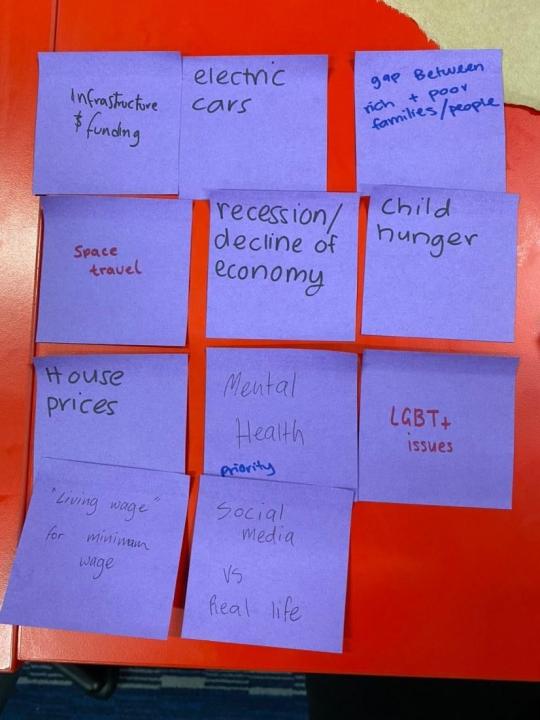
When brainstorming ideas there were lots of topics we found ourselves interested in but were leaning towards researching the LGBT+ community or mental health. As a group, we decided on the topic of mental health because there are lots of different directions we could go with this topic, and we felt this would be the most interesting.
What I learnt from this activity is that I need to do lots of research to understand a topic so I am not misled by headlines or bias. I can use this new knowledge and experience when begin researching as a group for our next assessment. It could also be useful for my Spatial Design class because I can be better informed about places and people that I am designing for.
Research
To have mental health disorders refers to a wide range of health conditions but all of which is to affect someone's mood, thinking and behaviour. If someone has good mental health this means that they are able to think, feel and react in appropriate ways that enable them to live their life while someone with poor mental health might find thinking, feeling or reacting very difficult. Mental health disorders affect people of all ages and can range from common problems such as depression and anxiety to rarer ones such as schizophrenia and bipolar disorder. (Mind, The Mental Health Charity, 2017) They can also have a wide range of causes such as trauma, isolation, poverty, unemployment and more with some people being more deeply affected by certain things than others. In many ways mental health is similar to physical health and should similarly be taken care of. (Mind, The Mental Health Charity, 2017)
In an investigation done in 2017 made from a combination of sources including medical and national records, epidemiological data, survey data, and meta regression model it was estimated that 792 million people lived with a mental health disorder. (Ritchie & Roser, 2018) This is slightly more than one in ten people globally (10.7%). As shown in Figure 1, we see that globally, mental and substance use disorders are very common with around 1 in 7 people (15%) having one or more mental or substance use disorders. (Ritchie & Roser, 2018)
Figure 1.

From Our World in Data, 2018, (https://ourworldindata.org/mental-health#licence)
In 2019/20 in New Zealand a total of 184,711 clients were seen by mental health and addiction services and out of these 51% were male and 49% were female. When looking at the ethnic groups reported, Māori were most likely to be seen by mental health or addiction services while Asians were least likely to be seen. (Ministry of Health NZ, 2021)
Globally around 800,000 people die from suicide every year and most cases can be linked to a diagnosed or undiagnosed mental health disorder. While suicide rates according to statistics are decreasing compared to past years this number is still very high with around twice as many people dying from suicide as from homicide. (Ritchie et al., n.d.) Amongst 15 to 29 year olds suicide is the second leading cause of death with many of them having what could have preventable severe mental health conditions. Despite progress in some countries, people with mental health conditions often experience severe human rights violations, discrimination, and stigma. (WHO | World Health Organization, 2019) Many mental health conditions can be effectively treated at relatively low cost, yet the gap between people needing care and those with access to care remains substantial. Effective treatment coverage remains extremely low. (WHO | World Health Organization, 2019)
References:
Mind, The Mental Health Charity. (2017, October). What are mental health problems? Mind.
https://www.mind.org.uk/information-support/types-of-mental-health-problems/mental-health-problems-introduction/about-mental-health-problems/
Mind, the mental health charity. (2017, October). What causes mental health problems? Mind. https://www.mind.org.uk/information-support/types-of-mental-health-problems/mental-health-problems-introduction/causes/
Ministry of Health NZ. (2021, June 30). Mental health and addiction: Service use 2019/20 tables. https://www.health.govt.nz/publication/mental-health-and-addiction-service-use-2019-20-tables
Ritchie, H., & Roser, M. (2018, April). Mental health. Our World in Data. https://ourworldindata.org/mental-health#licence
Ritchie, H., Roser, M., & Ortiz-Ospina, E. (n.d.). Suicide. Our World in Data. https://ourworldindata.org/suicide
WHO | World Health Organization. (2019, December 19). Mental health.
https://www.who.int/health-topics/mental-health#tab=tab_1
0 notes